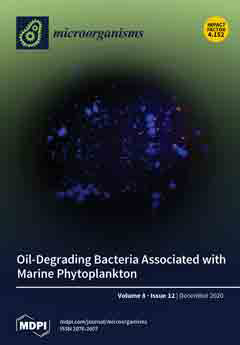Upland soils of tundra function as a constant sink for atmospheric CH
4 but the identity of methane oxidizers in these soils remains poorly understood. Methane uptake rates of −0.4 to −0.6 mg CH
4-C m
−2 day
−1 were determined by the static chamber method in a mildly acidic upland soil of the lichen-dominated forested tundra, North Siberia, Russia. The maximal CH
4 oxidation activity was localized in an organic surface soil layer underlying the lichen cover. Molecular identification of methanotrophic bacteria based on retrieval of the
pmoA gene revealed Upland Soil Cluster Alpha (USCα) as the only detectable methanotroph group. Quantification of these
pmoA gene fragments by means of specific qPCR assay detected ~10
7pmoA gene copies g
−1 dry soil. The
pmoA diversity was represented by seven closely related phylotypes; the most abundant phylotype displayed 97.5% identity to
pmoA of
Candidatus Methyloaffinis lahnbergensis. Further analysis of prokaryote diversity in this soil did not reveal 16S rRNA gene fragments from well-studied methanotrophs of the order
Methylococcales and the family
Methylocystaceae. The largest group of reads (~4% of all bacterial 16S rRNA gene fragments) that could potentially belong to methanotrophs was classified as uncultivated
Beijerinckiaceae bacteria. These reads displayed 96–100 and 95–98% sequence similarity to 16S rRNA gene of
Candidatus Methyloaffinis lahnbergensis and “
Methylocapsa gorgona” MG08, respectively, and were represented by eight species-level operational taxonomic units (OTUs), two of which were highly abundant. These identification results characterize subarctic upland soils, which are exposed to atmospheric methane concentrations only, as a unique habitat colonized mostly by USCα methanotrophs.
Full article






